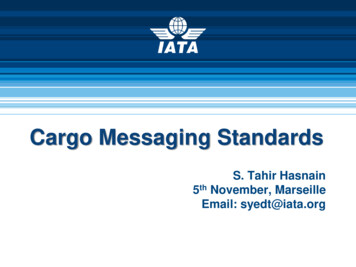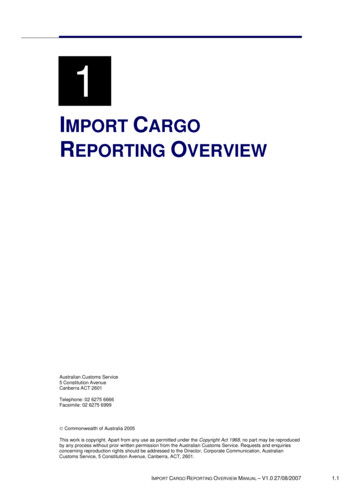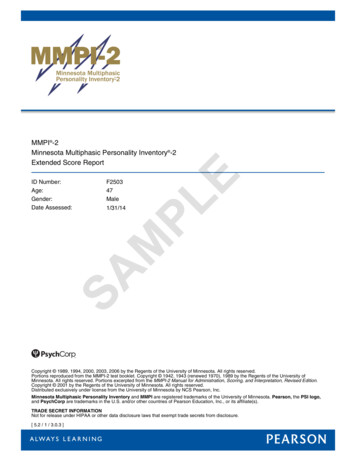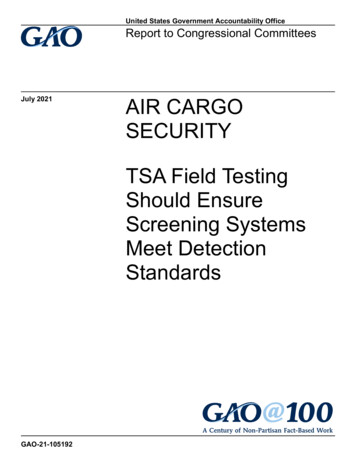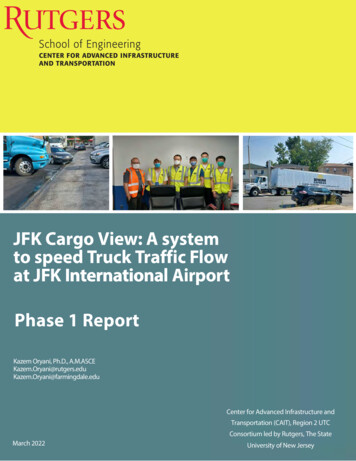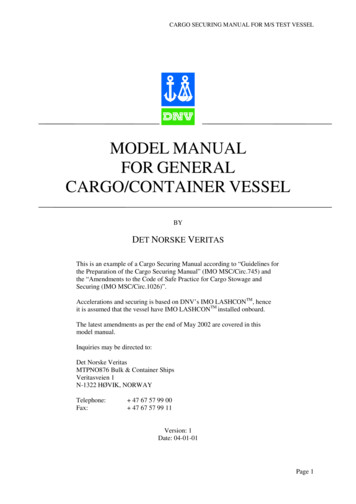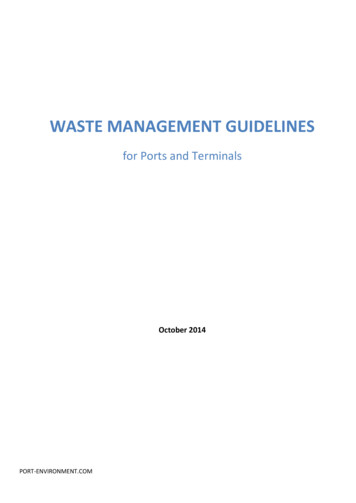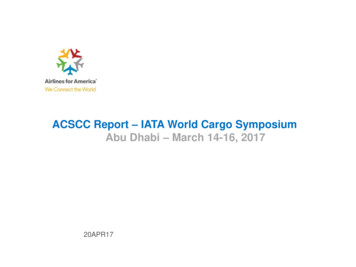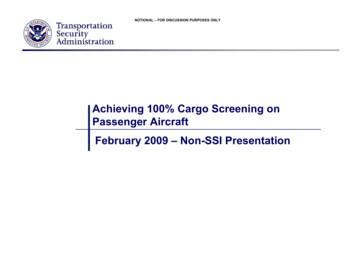
Transcription
NOTIONAL – FOR DISCUSSION PURPOSES ONLYAchieving 100% Cargo Screening onPassenger AircraftFebruary 2009 – Non-SSI Presentation
NOTIONAL – FOR DISCUSSION PURPOSES ONLYAgendaOpening Remarks100% Screening LegislationApproach to 100% Screening Narrow Body Amendment Certified Cargo Screening Program Freight Forwarder (IAC) ScreeningPolicy DetailsLooking AheadQ&A2
NOTIONAL – FOR DISCUSSION PURPOSES ONLY100% Screening LegislationBackground President Bush approved Implementing Recommendations of the 9/11 CommissionAct of 2007 on August 3, 2007. The legislation mandates 100% screening byAugust 2010 and requires TSA to:– Establish a system to screen 100% of cargotransported on passenger aircraft.– Provide a level of security commensurate to thatof passenger baggage.– Meet inspection benchmarks.Congressionally Mandated Cargo Screening Benchmarks9/11 Act50%100%August 2007February 2009August 20103
NOTIONAL – FOR DISCUSSION PURPOSES ONLY100% Screening Technology ToolsTSA Approved Screening Methods Physical search with verification of manifest or other packing document AT X-ray* Explosives Trace Detection (ETD)* Explosives Detection System (EDS)* Decompression chamber TSA operated canines Any other detection equipment accepted in the future by TSA*All technologies must be on the current TSA Screening Technology List which will be made available toscreening participants.5
NOTIONAL – FOR DISCUSSION PURPOSES ONLYFuture Air Cargo Supply ChainDistributing screening technology and responsibility across the supply chain.Risk AssessmentFreightForwarder**ScreeningUnited States Air CargoDistribution by Weight*Known CCSF: F:Shipper / 3PL /Manufacturer(Known Shipper)Notes:FreightForwarder**Screening must occur prior to consolidation.Screening methods: electronic, manual, and TSA canine.Ensure chain of custodyUnscreened cargo6Air Carrier
NOTIONAL – FOR DISCUSSION PURPOSES ONLYTSA’s Approach to 100% Screening TSA is pursuing the following initiatives to aid industry in achieving the100% screening requirements and milestones:– Narrow Body Screening Amendment– Phased Rollout of the Certified Cargo Screening Program (CCSP) Shippers in 9 cities Freight Forwarders (IACs) in 18 cities– IAC Screening Technology Pilot (STP) participants– Non-Pilot applicants7
NOTIONAL – FOR DISCUSSION PURPOSES ONLY100% Narrow Body Amendment TSA issued an amendment to the aircarrier screening programs requiring100% screening of cargo transportedon all narrow bodied passengeraircraft:# of Flights4%96%– Released on August 1, 2008.Narrow Body– Effective on October 1, 2008.Wide Body Requirement applies to originatingcargo tendered on narrow bodypassenger aircraft.– i.e., B-737, B-757, A-320 (and smaller)– Shrink-wrapped and banded exemptionsare removed under the amendment.8 96% of passenger flights arenarrow body. More than 80% of thepassengers and 25% ofcargo are carried on theseflights.
NOTIONAL – FOR DISCUSSION PURPOSES ONLYCertified Cargo Screening Program
NOTIONAL – FOR DISCUSSION PURPOSES ONLYCertified Cargo Screening Program OverviewTSA developed the philosophy behind the CCSP by working closely with U.S. andinternational agencies and associations to incorporate key aspects of commensuratesecurity programs: Customs-Trade Partnership Against Terrorism (C-TPAT) The UK’s Known Consignor ProgramCCSP was developed to: Allow screening of cargo early in the air cargo supply chain by a trusted, vetted, and auditedfacility. Establish the integrity of a shipment through enhanced physical and personnel securitystandards at Certified Cargo Screening Facilities (CCSFs). Maintain the integrity of a shipment throughout the supply chain by utilizing stringent chain ofcustody methods.Participation in CCSP is voluntary, but once in, CCSFs must: Adhere to increased TSA-directed security standards. Employ chain of custody. Permit onsite validations. Be subject to TSI-C inspections.10
NOTIONAL – FOR DISCUSSION PURPOSES ONLYWho can become a Certified Cargo Screening Facility?The CCSP is a facility based program. Facilities screening under the CCSP will be knownas Certified Cargo Screening Facilities (CCSFs). Facilities currently applying to become CCSFs:ShippingFacilitiesThird PartyLogistics utionCentersIndependent CargoScreening FacilitiesContractManufacturersFreight ForwardingFacilities Any entity with the desire to screen cargo must have a facility that can be secured. CCSFs must be no more than one node back from a currently regulated entity (freightforwarder/air carrier). Facilities that are not currently regulated by TSA will become regulated under the program.11
NOTIONAL – FOR DISCUSSION PURPOSES ONLYScreening Location Data Over 65% of all passenger air cargo originates from 18 airports/major pTop 66 AirportsAirportsNext 12 ATL0.0%ORD0.0%LAX33.3%JFK25.0%Percentage of All Passenger Aircraft Wide Body Cargo (Tons)Percentage of All Passenger Aircraft Cargo100.0%Indicates city where shipper facilities are targeted during Phase One Deployment in parallel with freight forwarding facilities.12
NOTIONAL – FOR DISCUSSION PURPOSES ONLYIAC Screening Technology Pilot OverviewAs part of the Certified Cargo Screening Program, TSA is conducting an IACScreening Technology Pilot (STP).TSA’s objectives for the STP are: To assist industry in achieving the screening requirements of the Act by creating screeningcapacity at the IACs To measure the effectiveness of select screening technologies on various commodity classes To evaluate chain-of-custody procedures for screened cargo as it moves from the IAC to the aircarrier.IACs participating in the STP must: Have a facility located in one of the 18 major gateways Have a minimum annual volume of 200 consolidations (ULDs) tendered to passenger aircraft Sign an Other Transactional Agreement (OTA) to receive funding from TSA Provide detailed reporting on cargo volumes screened and screening technology dataAdditional Information13
NOTIONAL – FOR DISCUSSION PURPOSES ONLYMaster List CCSF Master List will identify IACs, Shippers, and Independent Cargo Screening Facilitiesthat are active CCSFs.– Several tabs will be included in the Master List that will contain information on active IACs, Air Carriers,and active CCSFs.– CCSF tabs included in the Master List will reflect CCSFs that are newly certified or have decided towithdraw from the program. The Monthly Master List is published on the 15th of each month. The Weekly Supplemental List will be published on the IAC and Carrier web boards everyMonday.– Newly certified CCSFs (IAC, Shipper, ICSF) and entities who have acknowledged the IAC – 001 will bepublished each Monday on this list.14
NOTIONAL – FOR DISCUSSION PURPOSES ONLYProgram and Policy Details15
NOTIONAL – FOR DISCUSSION PURPOSES ONLYFacility Requirements All facilities must adhere to the following requirements prior to validation:Facility SecurityEmployee TrainingIdentify DesignatedScreening Area(DSA) andimplement requiredaccess controls,etc.All employees andauthorizedrepresentativesmust be trained asoutlined in ngmeasures that meetTSA’s standardsSubmit SecurityThreatAssessments(STAs) for requireddirect employeesand authorizedrepresentativesChain of Custody16
NOTIONAL – FOR DISCUSSION PURPOSES ONLYTendering Screened Cargo1. Cargo must be physically identified as screenedbefore tender.– TSA will issue size and sticker specifications, but will not work with a vendor to supply screeningidentification methods.CCSFFreightCargo must be visiblyidentified as screened.Tamper evident methods must beapplied at the piece level –method may vary for differentpackage types (e.g. box v. crate).Once all cargo pieces have been screened,they can be shrink-wrapped, etc.2. CCSFs must tender a certification statement that the cargo has been screened and is from aTSA-approved CCSF.HAWBCertificate Screened Complianceverification CCSF #24
NOTIONAL – FOR DISCUSSION PURPOSES ONLYJoining the Program25
NOTIONAL – FOR DISCUSSION PURPOSES ONLYWhy Join Decreased log jams (carrier delays) and expedited supply chain flow. Expedite supply chain flow. Ability to build and ship bulk configurations. Ability to ship certain cargo without potential invasive screening later on in thechain. Ability to maintain in-house packaging integrity.WARNING: This record contains Sensitive Security Information that is controlled under 49 C.F.R. Parts 15 AND 1520. No part of this record may be disclosed to persons without a “Need to Know,” as defined in 49 C.F.R. parts 15 AND 1520, except with the writtenpermission of the Administrator of the Transportation Security Administration or the Secretary of Transportation. Unauthorized release may result in civil penalties or other action. For U.S. Government Agencies, public disclosure governed by 5 U.S.C. 552 and 49C.F.R. parts 15 and 1520.26
NOTIONAL – FOR DISCUSSION PURPOSES ONLYCCSP Participation during Phase OneSteps to join the CCSP1. Contact CCSP@dhs.gov for a CCSF application.2. Submit application and all applicable Sensitive Security Information HandlingRequirements.3. Undergo CCSP assessment: During Phase One, TSA performs assessments at no charge. After PhaseOne, TSA-Approved Validation Firms will perform this function.4. TSA reviews facility assessment and makes final certification decision.5. Shippers Sign Order and IACs comply with Alternate Procedure.6. Receive Facility Certification from TSA HQ.27
NOTIONAL – FOR DISCUSSION PURPOSES ONLYLooking Ahead28
NOTIONAL – FOR DISCUSSION PURPOSES ONLYCCSP Policy Development Standards During Phase One:– Non-regulated entities will operate under a regulatory Order issued by TSA.– Freight forwarders and air carriers will operate under an Alternate Procedure(AP) to their standard security programs (SSPs). Upon publication of the Interim Final Rule (IFR), all IAC, Shipper, and IndependentCCSFs will operate under the Certified Cargo Screening Standard Security Program(CCSSP).29
NOTIONAL – FOR DISCUSSION PURPOSES ONLYIn Summary TSA has received a significant amount ofapplications during Phase One Deploymentand is currently assessing all applicants. TSAis considering an expansion to the programwhere airlines would be able to acceptscreened cargo from all domestic airports. TSA will begin to deploy TSA-ApprovedValidation Firms to perform assessments onCCSF-applicants. TSA Headquarters willcontinue to issue final certifications toqualified facilities. TSA will deploy an online managementsystem for application and certificationprocesses under CCSP. The Administration’s freeze on all pendingregulations will not likely impact the CCSPprogram or the IFR. CCSP is a voluntary program and may notappropriate for some entities. Your participation will help ensure security inthe air cargo supply chain.31
NOTIONAL – FOR DISCUSSION PURPOSES ONLYProgram UpdateCertified EntitiesFebruary 1st 50% Screening Milestone: Updates to Air Carrier programs have been released. 100% Narrow Body Screening.Released: August 1, 2008Effective: October 1, 2008 50% Screening requirement.Released: December 23, 2008Effective: February 1, 2009 CCSP acceptance procedures.Released: December 22, 2008Effective: February 1, 2009 TSA has certified 170 entities. 700 applications received (IAC/ICSF/shipper), 120 per SEA3SFO14SMF1112122WARNING: This record contains Sensitive Security Information that is controlled under 49 C.F.R. Parts 15 AND 1520. No part of this record may be disclosed to persons without a “Need to Know,” as defined in 49 C.F.R. parts 15 AND 1520, except with the writtenpermission of the Administrator of the Transportation Security Administration or the Secretary of Transportation. Unauthorized release may result in civil penalties or other action. For U.S. Government Agencies, public disclosure governed by 5 U.S.C. 552 and 49C.F.R. parts 15 and 1520.32
NOTIONAL – FOR DISCUSSION PURPOSES ONLYProgram/Document Update 12/23/2008– Released IACSSP/AOSSP/MSP final version (in effect February 1st, 2009). 12/23/2009– Released IAC – 001, 002 Amendments (CCSP Program).– Released Airline Acceptance AP’s.– Released Shipper Order.(all references related to then-current SSP’s) 1/22/2009– Released updated IAC – 001, 002 Amendments. References to IACSSP “Change 3” in effect 2/1/09. Added “goods damaged by inspection” (in alignment with carrier programs for 2/1/09).– Released updated airline acceptance APs Reference to AOSSP/MSP “changes” in effect 2/1/09. Future Plans– Consolidate all Screening, Chain of Custody requirements into single SSP.WARNING: This record contains Sensitive Security Information that is controlled under 49 C.F.R. Parts 15 AND 1520. No part of this record may be disclosed to persons without a “Need to Know,” as defined in 49 C.F.R. parts 15 AND 1520, except with the writtenpermission of the Administrator of the Transportation Security Administration or the Secretary of Transportation. Unauthorized release may result in civil penalties or other action. For U.S. Government Agencies, public disclosure governed by 5 U.S.C. 552 and 49C.F.R. parts 15 and 1520.33
NOTIONAL – FOR DISCUSSION PURPOSES ONLYQ&AFor more information write to CCSP@dhs.gov34
CCSF-applicants. TSA Headquarters will continue to issue final certifications to qualified facilities. TSA will deploy an online management system for application and certification processes under CCSP. The Administration's freeze on all pending regulations will not likely impact the CCSP program or the IFR.
